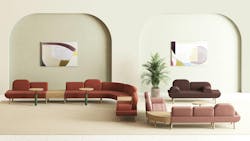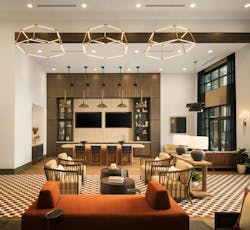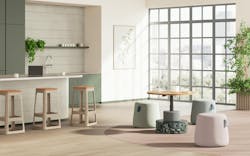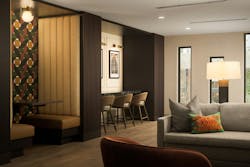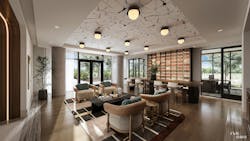With the current state of the multifamily industry in flux thanks to rising rents and interest rates, an affordable housing crisis, and supply-chain problems, designers and their clients are hunting for ways to boost occupancy.
Turns out the not-so-well-kept secret there has been lying within the amenity spaces that make these properties much more than just a home.
“It’s actually never been a better time to compete—even if you’re only a mid-size developer, or just doing a value-add renovation rather than a sexy new build—and that’s because of this amenities race,” confirmed Diana Mosher, multifamily trendspotter and principal designer of Diana Mosher Associates LLC in New York City.
Flex Your Multifunctional Muscles
According to Mosher, one of the keys to unlocking their potential is making these spaces as flexible as possible, with easy turnover capabilities.
Tiffany Woodson, founder and CEO of Ink + Oro out of Dallas, agrees. “The most important element is that spaces transition well from day to night and from a work event to a social event, for example. A screening room can double as a presentation space; a coffee bar and co-working area can transition to a bar serviced in the evening by a third party.”
Furthermore, both stressed the importance of “holistic spatial design versus direct design,” as Woodson dubbed it, which allows a room to flex with residents’ needs as they evolve, rather than being fixed to the next big thing that will, eventually, run its course.
Raise the Bar with Modularity and Accessibility
Still, one consistency throughout the multifamily-housing amenity space arena has always been co-working—a trend that emerged much earlier than one might guess. Hint: It was not solely driven by the pandemic.
“We noticed this trend just before 2020, as the influx of multifamily development was already on the rise in Texas, Arizona, Colorado, and Florida, creating an ultra-competitive market that required more offerings,” Woodson explained. “Prior to this, the level of quality in Wrap product, not high-rise level, had a lesser concern for quality and expectation. Now, we have mid-rise products treated as high-rise quality, and high-rise competing as a condo or hotel-style, ultra-luxury market product.”
Translation: Expectations for ease of use are higher than ever. And they can be met in large part with a universal design approach that puts the spotlight on modularity and the power of the user.
“One thing we’re especially focused on right now is looking at creating solutions that work for everyone,” said Shawn Sowers, VP of design at Hightower, whose Considered Solutions product portfolio takes a modern approach to inclusivity, sustainability, and wellness that the multifamily market could highly benefit from.
Designed to meet and exceed ADA compliance standards, solutions should go even further by addressing the needs of neurodiverse individuals, providing more options for physical disabilities and limitations, and offering solutions to enhance specialized environments such as spiritual/prayer and wellness/lactation rooms. Pieces should be designed to be cognizant of wayfinding needs, and accommodating occupants in larger bodies, taking into consideration stability, safety, and their sense of belonging—all the while adhering to the most stringent sustainability and material-health guidelines.
Five Ways to Level Up Co-Working Amenity Spaces
Ink + Oro founder Tiffany Woodson provides a shortlist of tips for designers and building owners to consider in enhancing the amenities on multifamily properties.
- Choose materials that match the upgraded expectations of luxury mentioned earlier. Largely higher end yet durable equates to natural materials with longer lifespans, in our book.
- Don’t forget the lobby! Make it interactive, a place where residents can host their clients for a meeting—just like a coffee shop would.
- Focus on power, both with furniture integration and easily accessible Wi-Fi throughout a property.
- Look to the hospitality industry for trends on how guests utilize shared spaces. Multifamily will usually follow suit.
- While new builds present the most design opportunity for future-proofing, renovations—especially original builds from the pre-1970s—can provide some great bones to work with, devoid of heavy influence of technology. These are just raw spaces with materials like brick, stone, and steel that create unique aesthetics but need completely new infrastructure.
“One space has to do so many things in this arena, so for us, the focus is on fluid, adaptive solutions,” Sowers said. “The Draper table and its varying sizes is a great example for a multifamily amenity space, because sometimes you just want a coffee table to sit around and socialize at. Other times, you want to pull up chairs for either a casual or formal presentation and might have someone on a knee scooter or in a wheelchair; you might just want to have a standing meeting. Sometimes it’s happy hour.”
Other options include the nesting FourFold table that allows users to turnover a room themselves by simply flipping the table up, rolling it away, and reconfiguring. The modular Toward sofa has residential cues such as both high- and low-back elements and a bolster that’s movable for comfort and can be flipped over for a laptop.
Small details like these can activate typically static or passive furniture and help an amenity space come alive, allowing it to compete with the homes within a multifamily property (the struggle for all remote workers).
But it’s important to influence architecture first, then furniture, said Woodson. “If the space were to change, then what stands? This is our challenge.”
Check out the sidebar of Woodson’s multifamily co-working hot tips for more on how to meet that challenge head on.
About the Author
AnnMarie Martin
Editor-in-Chief
AnnMarie is the former Editor in Chief of i+s and has been covering the commercial design space. Her style and vision has helped the brand evolve into a thought leader in purpose-driven design and cultural movements shaping the way we live and work.
